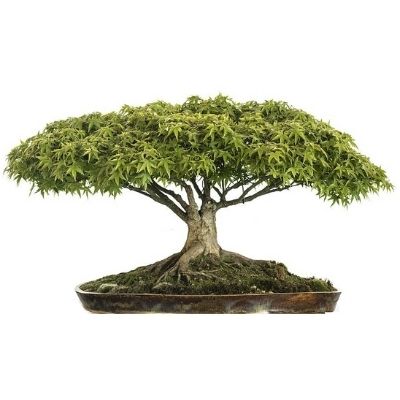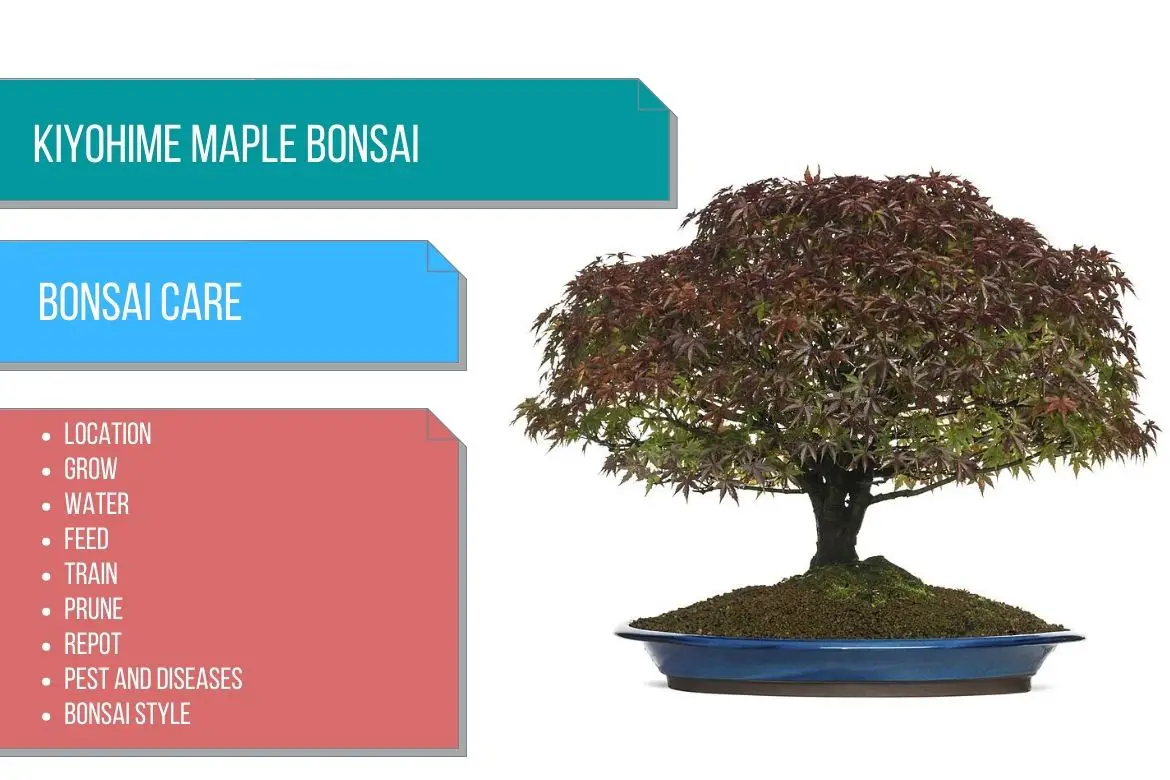
Kiyohime maple
(Acer palmatum ‘Kiyohime‘)
Country of Origin : Japan
Bonsai Styles : Twin trunk, broom, clump
Zone : 5 – 8
Acer palmatum ‘Kiyohime’ is a dwarf cultivar of Acer palmatum with a low, compact and horizontal spreading habit.
Its small, five-lobed, green leaves are surrounded by orange-red edges in spring, turning to rich green in summer, thereafter to yellow, orange, and red in fall.
Deciduous trees such as this one are among the first to emerge in spring and among the last to drop their leaves in the fall. There are many other cultivators of Japanese maple that can be used to make a bonsai tree. Please read 10 Best Japanese maple varieties for bonsai. Also read : 29 Types of Japanese Maple Bonsai You Must Try.
Kiyohime maple bonsai are quite rare, making them more expensive than other maple bonsai varieties.
The bonsai culture of kiyohime japanese maple bonsai is a little difficult because of 2 factors:
(i) an extremely slow rate of growth,
(ii) and a unique growing habit which makes it grow low and spread horizontally.
This very early form of ‘Yatsubusa‘ is very small and grows horizontally without a central leader.
Rather than growing vertically, the plant will grow sideways, leaving a hole at the top of the foliage canopy. This is why the majority of kiyohime trees are shaped like a “broom style bonsai”. They are difficult to train in any other bonsai style.
As soon as the bonsai style has been achieved, it requires a bit more attention and care than other maples bonsai.
In spite of the hassle, even very small bonsai can manage to present a convincing image of a full-grown tree thanks to their tiny, bright green leaves and dense tracing of fine twigs. This makes all the hardwork worthwhile.
For more info on other bonsai tree varieties, please read Types of bonsai trees.
In winter, when the fine twig structure of Kiyohime is visible, they are particularly beautiful. Five lobed, small leaves encased in an orange reddish frame look particularly attractive.

Best location keep Japanese Kiyohime maple Bonsai
The kiyohime maple bonsai must be kept outdoors at all times. These are outdoor bonsai trees. Continue reading Outdoor bonsai tree care.
Even though technically hardy, kiyohime bonsai grown in containers should be considered semi-hardy. Hence, protect the kiyohime Japanese maple bonsai from temperatures below freezing. To prepare the tree for winter dormancy, reduce the frequency of watering and cease fertilization. Continue reading Seasonal bonsai tree care.
The temperature range in which these trees can do well is 30-90°F (-1 to 32°C). However, if Kiyohime maple bonsai is subjected to temperatures above 86°F (30°C) for a prolonged period of time then the foliage of the tree might dry. Large Kiyohime bonsai might be a little tougher in these situations. Continue reading: Japanese maple bonsai winter care.
Try and keep the Kiyohime maple bonsai in the shadow of a large structure such as a fence or a house instead of keeping it in a place with overhead shadow.
The inherently weak apex of kiyohime bonsai is susceptible to losing its vigor and dying back if overhead shade is too dense.
When they are in leaf, you can display them indoors for a few days or you can display them indoors for a few hours during the winter.
Continue reading do bonsai trees need sunlight for more indoor and outdoor bonsai location ideas.
Propagation Kiyohime maple
Kiyohime Japanese maple seeds can be sown in winter.
Summer is the best time to take softwood cuttings.
In the spring or the summer, layer or air layer Japanese kiyohime maple.
Please read how to take care of Japanese maple bonsai saplings and also how to train a Japanese maple seedling into a bonsai.
Watering Kiyohime maple Bonsai
Water the roots regularly throughout the growing season and never allow the soil around the roots to dry out.
Water once a day in spring and fall; twice a day in summer. However, remember that the watering frequency depends on many factors such as local temperature, type of the pot used and the location of the bonsai. So, develop a routine which suits your bonsai the best.
In winter, water sparingly. Make sure that the soil is always moist, avoiding both waterlogging and dryness.
Mist the foliage regularly.
Keep in mind that generally Japanese maples trees need the soil to dry-out before they need water. Drying of the soil helps to roots to grow as the roots spread more in search of water. Hence, I always recommend NOT to use a humidity tray for Japanese maple. The humidity tray hinders the drainage and doesn’t allow the soil to dry sufficiently.
Avoid using tap water and use rainwater instead if you can as kiyohime bonsai needs slightly acidic soil.
One trick you can use is, each time you water, wait until the top of the compost is slightly dry.
Whenever you water these plants, make sure the water flows through the drainage holes in the bottom of the bonsai pot. Continue reading about bonsai pot drainage.
Continue reading about how to water a bonsai tree.
Wiring Kiyohime maple Bonsai
You should wire the branches when they are bare in the fall, before new growth begins in spring. Partially defoliated branches can also be wired.
Use aluminum wire as the branches are fragile. Wrap the wire with a wet cloth to avoid scarring the branches.
If you want to protect kiyohime maple stems from unsightly wire marks, wrap them in raffia.
Avoiding marking can be achieved by shaping with guy wires as well as by pinching and pruning.
Best time of wiring is also after fresh leaf cutting.
Please read our detailed guide on how to wire a bonsai tree. Also, refer to our detailed bonsai tools guide and how to take proper care of your bonsai tools to know about all the tools of bonsai.
Pruning Kiyohime maple Bonsai
When to prune Japanese kiyohime maple bonsai?
Pruning the central leader of kiyohime bonsai is not recommended. Don’t hard prune the leader or the upward-growing branches at the top. As the kiyohime maple bonsai topically don’t regenerate wounded apex.
Strong, healthy kiyohime bonsai trees should have their leaves pruned early in the summer.
In midsummer, pruning all the leaves (a total leaf cutting) will encourage growth of small leaves.
Pruning can also be performed in spring, two weeks before or after repotting. The new growth should be trimmed to 1-2 pairs of leaves in spring.
Late winter is the time to thin older twigs and major branches.
During the growing season, remove large leaves and trim for shape.
Eliminate branches and twigs that are overcrowded.
Note : A strict routine of pruning of dense, cluttered twigs should be observed, along with an annual thinning of dense, cluttered twigs.
Refer to how to prune a bonsai tree for more info on best practices and tips and tricks.
Pinching Kiyohime maple Bonsai
After two or four leaves have formed, pinch out the tips of all new shoots. Do this throughout the year as needed.
Prior to cutting back to two leaves, allow the apex to gain vigor.
Repotting Kiyohime maple Bonsai
When to repot Japanese Kiyohime maple bonsai?
Kiyohime maple bonsai is one of the earliest to leaf out, so repotting should be done relatively earlier than other maple bonsai varieties. (At least a couple of weeks earlier than other acer palmatum varieties).
Kiyohime Japanese maple cultivars should be repotted in early spring or late winter every two or three years, when the buds are elongating and shining.
Or you can also practice repotting smaller Kiyohime maple bonsai trees every year and larger Kiyohime maple bonsai trees every 3 years or so.
Generally, Kiyohime bonsai trees grow better in bonsai containers that are deeper.
After repotting, ensure the plant is frost-free.
Apply Akadama or standard soil mix (free draining). OR, you can use 50:50 ratio of akadama and perlite or lava OR you can also use basic bonsai potting soil.
If you live in a hardwater area, you should add sphagnum moss to increase the acidity of bonsai growing media.
You can read how to repot a bonsai tree to know more about the best guidelines to follow while repotting.
Feeding Kiyohime maple Bonsai
From bud-burst to late summer, use a Balanced feed, then a low-nitrogen or no-nitrogen feed.
You should not feed your tree during the winter when it is dormant.
A soil acidifier should be applied twice a year in hardwater areas.
Continue reading about bonsai fertilizer and its application.
Diseases and pest of Kiyohime maple Bonsai
As a result of the dense spreading foliage, aphids, spider mites, and various caterpillars seek protection there.
When pests are too many to be removed manually, apply a systemic insecticide.
Aphids can be little tricky due to their tendency to adopt the same color as the shoots they feed on, they are difficult to spot. You can spot aphids by looking for distorted young shoots. Apply a monthly spray against aphids.
When air circulation is poor, powdery mildew may develop.
Black spot fungi are occasional problems.
Refer the in-depth guide for bonsai pest and diseases identification and treatment for more details. Also, read best practices to keep your bonsai pest free.
Kiyohime maple bonsai care
The kiyohime maple is more delicate than other species of maple and requires more attention and discipline to maintain.
Sun or wind can easily scorch them, and they are more sensitive to dry roots or overwatering, and are less able to defend themselves against insects or fungi.
The branches at the apex of the tree should not be damaged in any way, since this part of the tree is weakest and lacks the vigor to recover.
During summer, protect the kiyohime Japanese maple bonsai from wind and direct sunlight.
In winter, store it in a shed or garage that is not heated but insulated. Avoid hard winters to prevent die-back of kiyohime bonsai.
Don’t overfeed or overwater your kiyohime bonsai, and don’t let the roots dry out.
The canopy will become too dense if older twigs are not pruned and new shoots are not allowed to replace them (not near the apex). As a result, the ends of many branches will shrivel due to lack of air and light.
Maintain a balanced, open canopy by trimming and thinning regularly throughout the growing season.
What to look for when buying Kiyohime maple Bonsai
Specimens of kiyohime bonsai are rare and expensive.
If you purchase a kiyohime maple, be sure that the apex and the central part of the canopy are healthy and growing.
Only opt for such trees if you are absolutely sure that you can hide the wound marks by carving.
Make sure the plant has a straight trunk with radial roots that are evenly distributed and a framework of branches that are evenly formed.
Even in the hands of experts, kiyohime bonsai tree with lopsided growth will rarely develop into good, well-balanced bonsai.
FAQs
Can I keep my Kiyohime maple Bonsai indoors?
While the Kiyohime maple Bonsai can be kept indoors for a very short period of time, it is generally recommended to provide it with outdoor conditions to thrive. Much like other Japanese bonsai tree varieties, its an outdoor bonsai tree.
Is it normal for my Kiyohime maple Bonsai to lose leaves in winter?
Yes, it is normal for the Kiyohime maple Bonsai to lose leaves during winter as it enters a dormant period. Monitor the moisture levels and protect the Bonsai from freezing temperatures to ensure its health.

